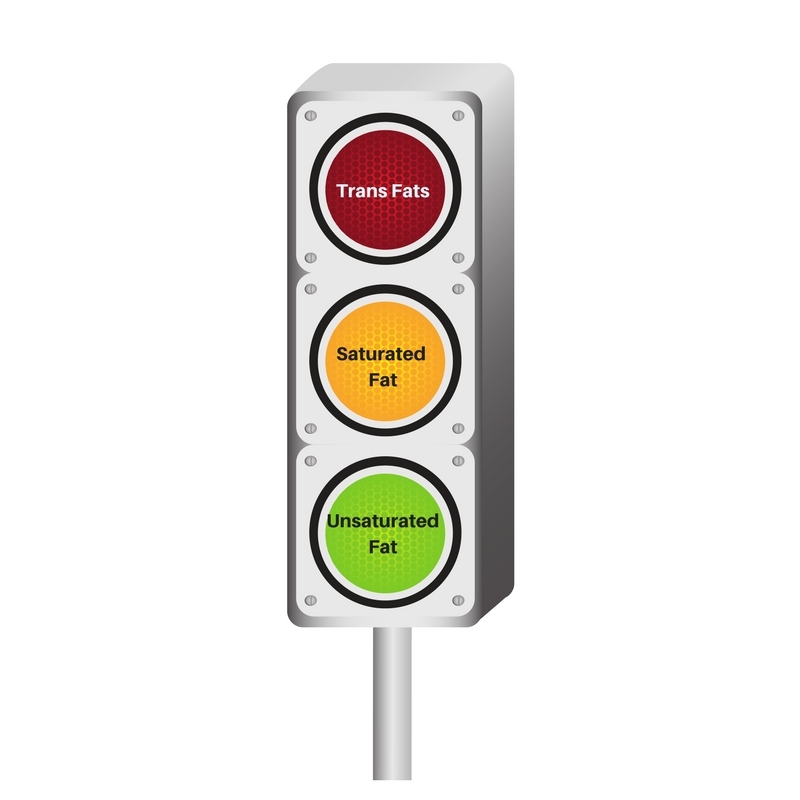So, last we met, we spoke about sugar addiction. Hopefully, you’ve spent the last couple of weeks decreasing your sugar intake. But, now what? We eat sugar because it makes food taste good. Are we doomed to boring, bland tasting foods? Not at all. Enter fat.
Now I know your doctor has been telling you for years to reduce your fat intake, but what if he’s wrong? What if you can actually increase your fat intake, make your food taste delicious, and STILL be healthy? How can this be true? Let me explain.
There are 3 types of fat, trans fat, saturated fat and unsaturated fat. We’re going to go with the stop light analogy here and say NO to trans fats, CAUTION with saturated fats and GO! with unsaturated fats. It’s seriously that easy.

Let’s talk about trans fats. Trans fats are created by adding hydrogen to liquid vegetable oil. This process enables the oil to become a solid. It also increases the cooking set point, so it allows foods to be fried at a higher temperature and it can be reused over and over. Trans fats, or partially hydrogenated oils, are also used in many processed foods because they’re cheap, easy to use, taste good and give the food a longer shelf life. But… Remember in the last blog we talked about the processing of processed foods?
What do trans fats do to your health? Nothing good. Trans fats increase your bad cholesterol (LDL) and decrease your good cholesterol (HDL). They cause inflammation in your body and significantly increase your risk of diabetes, heart disease and stroke. In fact, in 2015, the FDA deemed trans fats as not “generally recognized as safe” in human food. Wow! Trans fats are so dangerous to your health, that by the year 2018, they are banned as a food source.
Do you see why trans fats are RED on the stoplight? Do not use these fats as your fat source.
Trans fats can be found in pizza, cookies, crackers, cake, doughnuts, fried chicken and other fried foods, french fries, biscuits, margarine, and most fast food. This list is by no means comprehensive, but it will give you a general idea.
Saturated fats are fats that are typically solid at room temperature and are “natural” rather than man made. They come from a variety of sources including beef, lamb, pork, the skin of poultry, cheese and many dairy products, butter and certain oils like palm oil and coconut oil.
Saturated fat has gotten a bad rap for a long time because scientists believed that it caused bad cholesterol (LDL) to go up and caused plaque build up in our arteries. There are several good recent studies, including the PURE study which came out this year, that indicate that while saturated fat likely will make your LDL go up, it does not cause a plaque buildup in your arteries. These recent studies indicate that processed foods and sugar, which cause widespread inflammation in the body, are actually the root cause of heart disease, stroke and diabetes.
In light of these recent studies, we give saturated fat a YELLOW on the stop light. They are okay to eat in moderation.
This leads us to the holy grail of fat, unsaturated fat. Unsaturated fat is considered “good fat” and is liquid at room temperature. Unsaturated fat is further broken down into poly unsaturated fat and mono unsaturated fat. Poly unsaturated fat is a good source of Omega 3s. Omega 3s protect our bodies from inflammation and we must get them from the food we eat. Wild caught salmon and flax seed are excellent sources of Omega 3s.
Unsaturated fat raises your good cholesterol (HDL) and lowers your bad cholesterol (LDL). It is considered cardio protective and lowers your risk of heart disease, stroke and diabetes. Fish, nuts, seeds, avocado and plant oils, like olive oil and sunflower oil are examples of unsaturated fat.
Unsaturated fat gets a GREEN light on the stoplight. From a health perspective, you don’t really need to limit these fats; however, if you are trying to lose weight, too much of any fat will inhibit your weight loss.
To recap. Fat is actually not bad for you, as long as you are eating the appropriate fat. Do not eat trans fat, just don’t. You can eat saturated fat in moderation and may have unlimited unsaturated fat. If you are trying to lose weight, I would limit fat to less than 75 grams a day.
So, in actuality, between sugar and trans fats, we have eliminated processed food as a food source. A down and dirty way to understand if food is processed is: if it goes bad, it’s good for you; if it doesn’t go bad, it’s bad for you.
Next week I will introduce the Choose You food pyramid and how you can incorporate this lifestyle into your life.
Your Health. Your Journey. Your Choice. Choose You.


